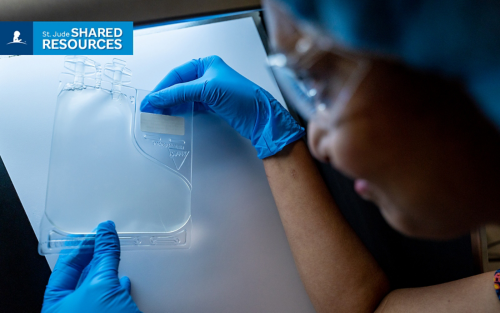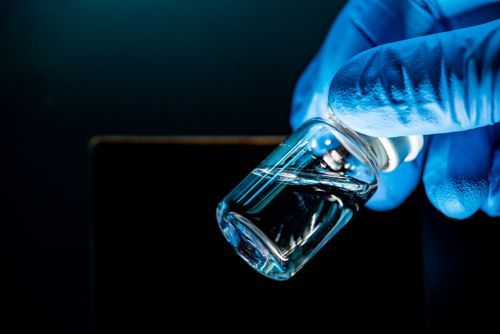St. Jude Family of Websites
Explore our cutting edge research, world-class patient care, career opportunities and more.
St. Jude Children's Research Hospital Home

- Fundraising
St. Jude Family of Websites
Explore our cutting edge research, world-class patient care, career opportunities and more.
St. Jude Children's Research Hospital Home

- Fundraising
Shared Resource Spotlight: The Good Manufacturing Practice (GMP) Facility

GMP staff member visually inspecting cellular therapy products during quality control.
“From bench to bedside.” It’s a credo heard every day at St. Jude. As impactful as it is, it’s missing something. How does a potential therapy get from bench to bedside? And how does this whole process happen entirely within St. Jude?
In the far northwest corner of the St. Jude campus stands a 64,000-square-foot building called the Good Manufacturing Practice (GMP) facility. Inside, the transition from a laboratory discovery to a tangible clinical therapeutic happens. It’s not magic, but the unique and highly specialized techniques and technologies used in the GMP facility can feel almost magical.
The GMP facility can manufacture specialized, lifesaving therapeutics that may otherwise never see the light of day. In the 20 years since its grand opening, the GMP facility has been integral in producing vaccines, gene and cellular therapy products, monoclonal antibodies, and recombinant proteins for pediatric patients, thereby supporting the St. Jude mission of opening clinical trials and advancing current standards of care for pediatric cancers and other catastrophic diseases.
A unique necessity: manufacturing therapeutics on-site
When clinical investigators generate an idea for a novel therapeutic, they face the brutal reality that bringing that treatment to clinical trials may never happen. Even if preclinical data support the efficacy of the proposed new therapy, it can be difficult to get major pharmaceutical companies to buy in and further develop the therapy.
“The costs associated with the translational work of developing a process that is both GMP compliant and appropriate for clinical scale manufacturing can easily approach ten million dollars,” says Frank Fazio, President of the Children's GMP and Vice President of Therapeutics, Prod. He continues, “This part of the therapeutics discovery life cycle is often very difficult to finance. There are very limited federal grant opportunities for this phase, and this phase is often too risky for industry investment.”
When St. Jude opened the GMP facility, it created a workaround for these problems. Now, investigators can develop, scale-up and manufacture certain therapeutics for early-phase clinical trials completely within the gates of St. Jude.

An up close and personal look at the life-saving therapeutics manufactured by the GMP facility.
The GMP facility works closely with clinical investigators, the Human Applications Laboratory (HAL), the Department of Vector Development, and the Experimental Cellular Therapeutics Lab (ECTL) to develop pediatric therapeutics. Each of these entities is essential in creating viable, effective products that can be scaled up and manufactured inside the GMP facility.
A system for success
To showcase how “bench to bedside” development of new treatments happens, we can highlight the production of chimeric antigen receptor (CAR) T cells. With CAR T–cell therapy, a patient’s T cells can be collected and re-engineered to contain a CAR targeting a cancer-specific antigen. The CAR on the modified immune cell binds the cancer-specific antigen, activating the therapeutic T cell and causing cancer cell death.
Together, the clinical investigator and leaders of the GMP facility, HAL, Vector Development, and ECTL decide how to convert a translational idea into a product suitable for clinical trials. Protocols and materials, such as viral vectors, are provided to the GMP facility, which is ultimately responsible for physically producing the CAR T cells on a larger scale.
“There is an opportunity for GMP consideration during every step of the design,” says Fazio. “The materials and protocols provided to us by our partners in research can be optimized for use in the GMP so the tech transfer and scale-up can be conducted with significantly less risk. That is a huge, time-saving advantage.”
The ability to create therapeutics entirely in-house provides investigators with flexibility. The GMP facility has the unique capability to quickly manufacture enough products to allow for first-in-human trials. They can then turn around and make further modifications for the next clinical trial phase without starting from scratch.
The products manufactured by the GMP facility enable breakthroughs in basic and translational science to make it to the clinic where they can make a difference; they turn ideas into reality and give children more potential treatment options. Plus, clinical trial data is generated, which can entice major pharmaceutical companies to take over the large-scale development and marketing of the therapeutic, making it possible to treat a larger population of children.
Twenty years of impact: GMP products that led to breakthroughs
The GMP facility produces 30 cellular products annually and holds up to four yearly biomanufacturing campaigns. Its partnership with clinical investigators has resulted in unparalleled success in advancing treatments and cures for pediatric illnesses.
“The GMP plays a critical role in all our translational gene therapy and cell therapy efforts,” said Stephen Gottschalk, MD, Chair of the Department of Bone Marrow Transplantation and Cellular Therapy. “For example, the GMP was instrumental in developing our gene therapy approach to cure children with severe combined immunodeficiency. Likewise, it has generated all clinical grade vectors and cell products for our pediatric cancer immunotherapy program.”
The GMP has also manufactured clinical-grade products for the following pediatric ailments:
X-linked severe combined immunodeficiency (SCID-X1)
The GMP facility manufactured modified blood stem cells that harbor a lentivirus containing a normal copy of interleukin 2 receptor gamma (IL2RG). This gene is commonly mutated in children with SCID-X1, and that mutation prevents T-lymphocyte development. The findings, published in the New England Journal of Medicine, show that providing a correct copy of IL2RG results in functional immune cell production.
Factor IX hemophilia
The GMP facility produced an adeno-associated virus (AAV) vector to treat factor IX hemophilia. This gene therapy uses an AAV vector to carry a functional factor IX gene into the body, allowing the blood to clot properly. The findings, published in the New England Journal of Medicine, show that this gene therapy increased the amount of blood-clotting protein and lessened the severity of the condition. The GMP facility has produced both modified immune effector and stem cells.
Neuroblastoma
The GMP facility manufactured monoclonal antibodies against disialoganglioside GD2 (GD2) to treat neuroblastoma. Anti-GD2 antibodies target GD2, an antigen on the tumor’s surface, and cause tumor cell death. The findings, published in the Journal of Clinical Oncology, show that giving anti-GD2 drastically increases the survival rate for children with high-risk disease.
Blood cancers and solid tumors
The GMP facility produced genetically modified immune cells that have been integral in advancing cellular therapy targeting B-cell ALL, relapsed or refractory solid tumors, acute lymphoblastic leukemia and acute myeloid leukemia.
Critical reagents and raw materials
The GMP facility has also produced novel vaccines, zoonotic candidate vaccine viruses, recombinant proteins, human challenge viruses and important materials, such as the Cas9 nuclease used in genome base editing.
Growing by leaps and bounds
The GMP facility houses 60 employees and includes the Department of Therapeutics, Production and Quality (TPQ), which oversees process and assay development, and the Children’s GMP, LLC, which oversees current GMP manufacturing and includes Quality Assurance, Quality Control and cGMP Production.
When discussing the future of the GMP, Fazio said, “The GMP will be an important translational asset for St. Jude over the next 20 years. I believe the ranges of technologies and therapies supported by the GMP will increase, and a greater number of researchers in diverse areas of research will benefit from enhanced translational support.”






